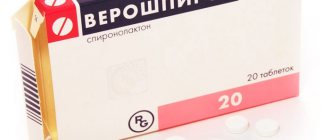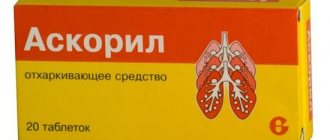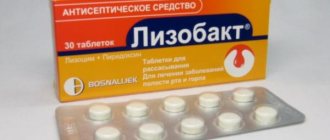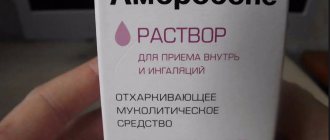Composition and principle of action of the drug ACC
Cough is the body's protective reaction during colds. There are two types of it - dry and wet. When a patient coughs wetly, a special secretion is released from the bronchi, which is called sputum. It binds pathogenic microorganisms, which are removed from the bronchi along with the cough.
Often an excessive amount of sputum is produced, it becomes thick, and in this case its removal is difficult. As a result, the patient suffers, unsuccessfully trying to cough it out. This affects sleep at night and worsens health. Acetylcysteine comes to the rescue in this situation.
ACC is a drug for the treatment of cough with anti-inflammatory and expectorant effects. It is produced in Slovenia and Germany, and is available in different forms.
The composition of each of them is different, although the active ingredient is the same - acetylcysteine. Its concentration in different forms of the drug is different.
Excipients included in one form or another of the drug include:
- in effervescent tablets – citric acid, ascorbic acid, sodium citrate, sodium carbonate, saccharin, bicarbonate, milk sugar, mannitol;
- in granular powder – ascorbic acid, sucrose, honey-lemon (orange) flavor, saccharin;
- in syrup - carmellose, methyl parahydroxybenzoate, disodium edetate, water, saccharinate, sodium benzoate, cherry flavor;
- in solution for inhalation (or injection) – sodium edetate, ascorbic acid, sodium hydroxide, sterile water.
The main objectives of the drug are: improving expectoration, fighting inflammation and thinning sputum. ACC breaks down disulfide bonds between mucus molecules, making the latter less sticky and viscous. During the rupture of these connections, the consistency of sputum changes, making it easier to clear from the respiratory system. By increasing cough productivity, the air entering the bronchi circulates freely and does not irritate the nerve endings.
As a result of taking a mucolytic, the cough intensifies and becomes even more pronounced. There is no need to panic or be frightened, because this indicates that the child is recovering. The cough gradually decreases and eventually disappears completely.
The high effectiveness of the mucolytic drug is achieved thanks to cysteine, which is formed during the passage of the drug through the liver. It is this active substance that has a therapeutic effect.
Analogs
In addition to ACC, there are several other agents with a similar effect for liquefying and removing sticky mucus. Some of them contain acetylcysteine, others contain another active substance. Analogues of ACC, indicating the composition, release form, dosage and average price are presented in the table below.
| Name | Active substance (composition) | Release form | average price |
| Acetylcysteine (producing country Estonia) | Acetylcysteine | Effervescent tablets 200 mg, 24 pcs. | 245 rub. |
| Fluimucil (manufacturing country Italy) | Acetylcysteine | Granules 200 mg, 20 pcs. | 190 rub. |
| Bromhexine (manufacturing country Latvia) | Bromhexine | Syrup 4 mg/5.0 ml; 100 ml | 125 rub. |
| Gedelix (manufacturing country Germany) | Ivy extract | Syrup 100.0 ml | 360 rub. |
A more expensive analogue of ACC is Gedelix.
A huge advantage of ACC for children is its ability to fight even residual cough, which does not go away for a long time and exhausts the baby. The drug rarely causes side effects or allergies, has a pleasant smell and taste, so children like it. In addition, it has earned excellent reviews from mothers and pediatricians.
Svetlana Sharaeva
Indications for use in children
Pediatricians prescribe treatment with ACC for children if the patient:
- respiratory disease, accompanied by the release of a viscous sticky secretion - sputum;
- acute or chronic form of bronchitis;
- pneumonia;
- acute inflammation of the middle ear;
- lung abscess;
- infectious and inflammatory damage to the larynx and trachea, accompanied by signs of acute respiratory infection;
- spastic bronchitis;
- bronchial asthma;
- inflammation of the trachea;
- bronchiectasis;
- sinusitis in acute or chronic form;
- cystic fibrosis;
- postoperative complications.
The drug is able to dilute not only viscous sputum, but also accumulated pus. For this reason, ENT doctors prescribe it for the treatment of rhinitis, otitis media or sinusitis.
special instructions
For bronchial asthma and obstructive bronchitis, acetylcysteine should be prescribed with caution under systematic monitoring of bronchial patency.
If side effects develop, you should stop taking the drug.
When dissolving the drug, it is necessary to use glass containers and avoid contact with metals, rubber, oxygen, and easily oxidized substances.
ACC® (in the form of granules for oral solution /orange/ 100 mg and 200 mg) 100 mg corresponds to 0.24 XE, 200 mg - 0.23 XE.
ACC® (in the form of granules for the preparation of an oral solution 200 mg) corresponds to 0.21 XE, ACC (in the form of granules for the preparation of an oral solution 600 mg) - 0.17 XE.
Forms of release of ACC and method of application
For ease of use, ACC is available in several forms:
- syrup;
- powder (granules) in sachets for preparing a hot drink;
- effervescent tablets;
- injection solution.
The pediatrician, depending on the patient’s age and the nature of the disease, may prescribe one or another form of acetylcysteine. Let's consider the features of their reception in more detail.
Powder for dilution
One of the forms of release of acetylcysteine, which dilutes sputum, is an easily soluble powder, packaged in individual 3-gram sachets with a dosage of 100 and 200 mg of the main substance. ACC powder for dilution is available in two different flavors - orange and lemon with honey.
To obtain a suspension, acetylcysteine powder is poured into hot water until it is completely dissolved. A solution is prepared at the rate of 100 mg of product per 100 ml of liquid. In addition to water, juice or warm tea can be used as a liquid for diluting granules.
To prepare the medicine, the use of metal utensils is excluded, since as a result of the reaction, substances harmful to human health are released. Ceramic or glass dishes are ideal.
After preparation, the resulting suspension is taken orally, regardless of food intake. It will be ideal if the baby drinks it immediately after preparation. If for some reason this cannot be done, then after three hours the suspension will become unsuitable for use.
A significant advantage of powdered medication, compared to other dosage forms, is rapid absorption, as a result of which the therapeutic effect of taking the medication occurs faster. Also, to enhance the medicinal effect, the child must be given plenty of fluids to drink.
Fast dissolving effervescent tablets
White effervescent tablets are another form of release of the mucolytic cough medicine ACC. They have a round, flat-cylindrical shape, have a blackberry aroma and are used to quickly prepare a medicinal drink. The product is produced in cardboard tubes of 20 pieces. One tablet contains 100 mg (for children) or 200 mg (for adults) of the active ingredient.
During dissolution, the ACC tablet hisses strongly and many small bubbles come out of it. The prepared solution is transparent and colorless. It may emit a faint sulfur odor.
To obtain an effervescent drink, the required number of ACC tablets (according to the instructions) should be diluted in 1 glass of water. You should drink the resulting medicine immediately after preparing it. The instructions recommend doing this after eating. Parents should monitor the patient's drinking regime. Drinking plenty of fluids helps achieve better effectiveness of the drug.
Syrup
Especially for children, the drug ACC is available in the form of syrup. It is a transparent liquid with a low viscosity. The syrup has a cherry flavor.
Cough medicine is bottled in 100 and 200 ml bottles in dark glass bottles, which significantly increases the shelf life of the medicine. In addition to the drug, the cardboard box contains a 10 ml measuring cup and a 5 ml dosage syringe. The bottles have a special protection system that prevents children from opening them.
ACC syrup contains no dyes or ethyl alcohol. 1 ml of the drug contains 20 mg of active substance.
Medicinal acetylcysteine syrup is given to children only after meals. Like other drugs of the mucolytic group, it should not be taken later than six o’clock in the evening, and especially before bedtime. This will have the opposite effect, and the liquefied sputum will provoke a severe coughing attack.
In order for the mucus to leave the respiratory tract faster, the sick baby, in parallel with taking ACC syrup, needs to massage the back and chest. Proper massage helps improve blood circulation in the lungs and remove mucous masses. As a result of this therapy, the child’s recovery will occur much faster.
Concept
Asist is used by patients suffering from acute and chronic types of bronchitis, inflammation of the trachea, bronchiectasis and other ENT diseases. The medicine is a fairly serious drug, so before use, you should study the instructions for Asist for cough.
Asist is available in granules, capsules and syrup
It can be used for inhalation. Adults and children over six years of age are recommended to take no more than 20 mg three times a day. Like most medications, if the dosage is incorrect or if the prescribed regimen is not followed, the drug may cause side effects:
Ambroxol for cough
- nausea;
- blood from the nose;
- vomiting;
- sometimes intestinal upset;
- heartburn.
The duration of the course depends on the course and form of the disease. For acute bronchitis and tracheobronchitis, take from 3 days to two weeks, for chronic forms of disease - two to three weeks.
Important! Before you start using Asist, you should pay attention to its effect with other medications. It is practically compatible with all medications; only antibiotics can be taken after waiting two hours after taking Asist.
Treatment regimen: frequency of administration, number of days
The pediatric dose of ACC depends on the form in which the doctor prescribed the drug and the age of the young patient. The number of receptions and their frequency depend on individual indicators. Let's consider the approximate daily dosages of three forms of mucolytic drug for children of different age categories.
Syrup:
- 2–3 times 5 ml (children aged 2 to 6 years);
- 3–4 times 5 ml (children from 6 to 14 years old);
- 2-3 times 10 ml (for those over 14 years old).
Suspension prepared from powdered ACC 100 mg:
- 2-3 times 1 packet (children aged 2 to 6 years);
- twice a pair of packages (children from 6 to 14 years old);
- three times a pair of packages (for those over 14 years old).
Tablet form of acetylcysteine 100 mg:
- 2-3 times 1 tablet (children aged 2 to 6 years);
- twice a pair of tablets (children from 6 to 14 years old);
- three times a pair of tablets (for those over 14 years old).
The average duration of drug therapy, whether it is children's syrup, tablets or powder in bags, is from 5 to 7 days. Only the attending physician can extend the course of treatment.
The daily dose of mucolytic for children under two years of age is prescribed by the doctor on an individual basis. As a rule, syrup is used in a volume of 2.5 ml 2-3 times a day. The medication is given to children only after meals.
Doctors rarely prescribe medications with an expectorant effect to newborn babies. This is due to the fact that the airways of recently born babies are too narrow, and the pectoral muscles have not yet become stronger. The child simply will not be able to cope with the increased volume of secretions and cough it up.
Compatibility with other drugs
When prescribing the drug ACC 100 for children to a small patient, the doctor must take into account the fact that its combination with other drugs can lead to an adverse reaction. It is strictly forbidden to combine acetylcysteine with cough medications, since sputum stagnation may form in the bronchi as a result of cough suppression. Parallel treatment with nitroglycerin and ACC leads to the fact that the vasodilator effect of the latter becomes more pronounced.
It is not advisable to combine acetylcysteine with antibiotics taken orally. The interaction of penicillin, tetracycline, cephalosporin, etc. with the thiol group of ACC can lead to a decrease in the antibacterial effect.
For this reason, a time interval of at least two hours should be maintained between taking a mucolytic and an antibacterial drug (with the exception of Loracarbef and Cefixime).
Contraindications for use in children
Acetylcysteine has a number of contraindications, so before you start treating your baby with a mucolytic drug, you should read its instructions. The use of ACC is contraindicated for a child if he:
- hepatitis;
- kidney or liver diseases affecting their functionality;
- hypersensitivity to acetylcysteine or other components of the drug;
- pulmonary hemorrhage;
- gastrointestinal diseases;
- peptic ulcer;
- discharge of blood with sputum during coughing;
- age up to 24 months;
- fructose intolerance;
- bronchial asthma.











